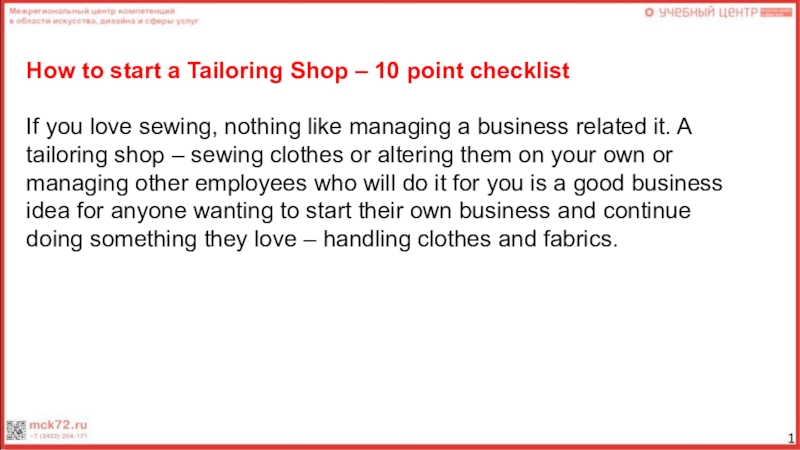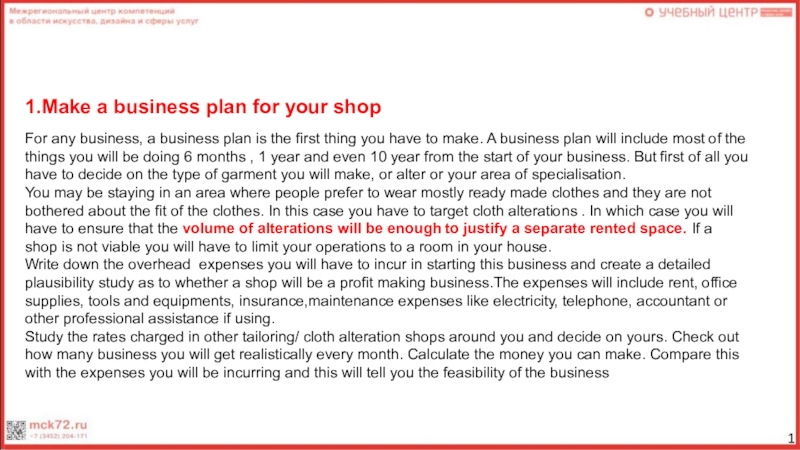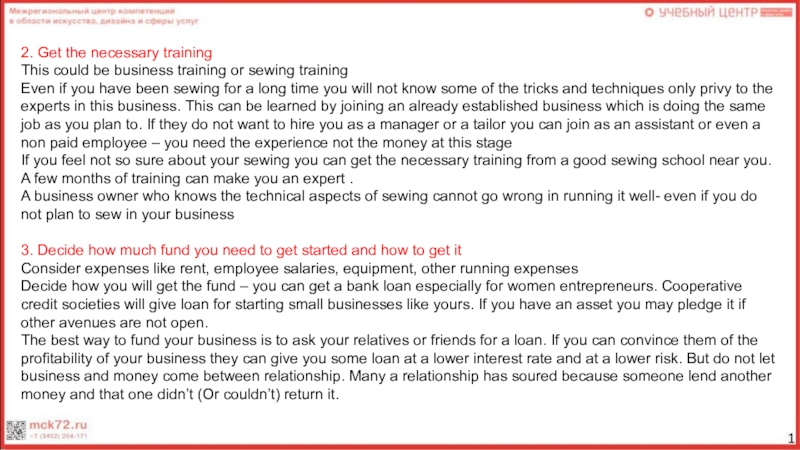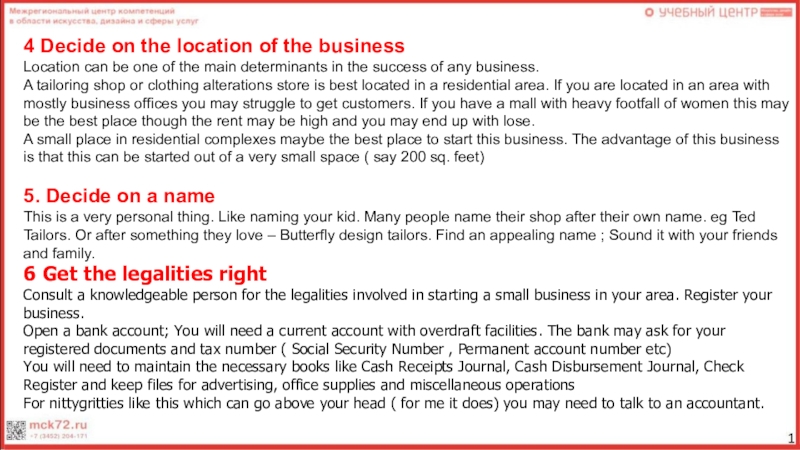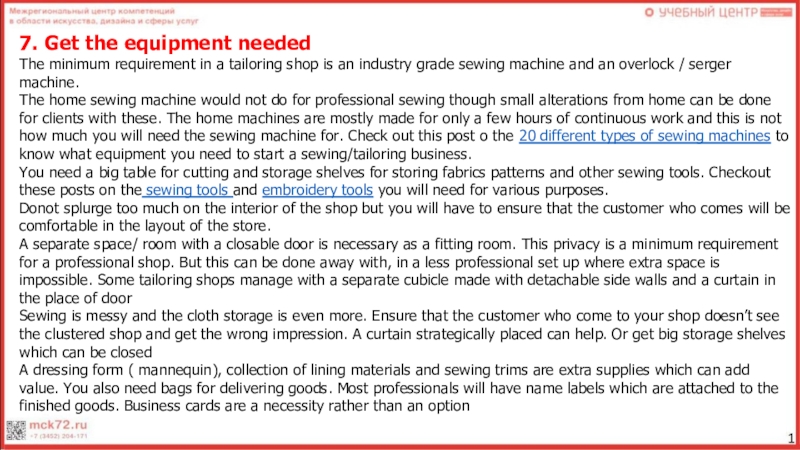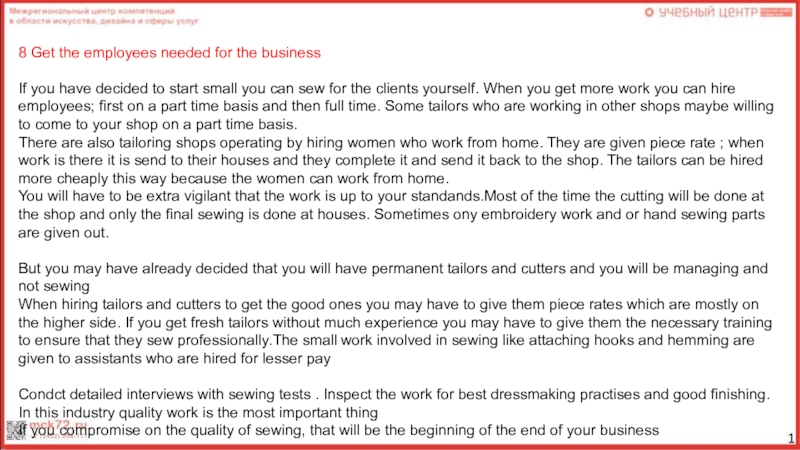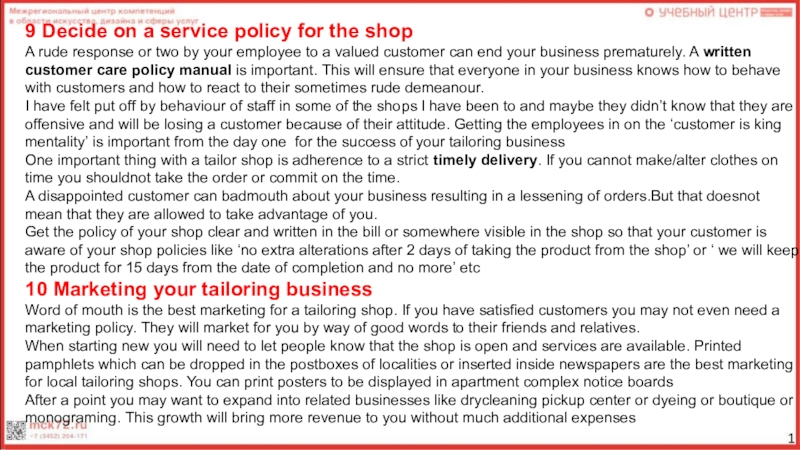Разделы презентаций
- Разное
- Английский язык
- Астрономия
- Алгебра
- Биология
- География
- Геометрия
- Детские презентации
- Информатика
- История
- Литература
- Математика
- Медицина
- Менеджмент
- Музыка
- МХК
- Немецкий язык
- ОБЖ
- Обществознание
- Окружающий мир
- Педагогика
- Русский язык
- Технология
- Физика
- Философия
- Химия
- Шаблоны, картинки для презентаций
- Экология
- Экономика
- Юриспруденция
How to start a Tailoring Shop – 10 point checklist If you love sewing, nothing
Содержание
- 1. How to start a Tailoring Shop – 10 point checklist If you love sewing, nothing
- 2. 1.Make a business plan for your shopFor
- 3. 2. Get the necessary trainingThis could be
- 4. 4 Decide on the location of the
- 5. 7. Get the equipment neededThe minimum requirement
- 6. 8 Get the employees needed for the
- 7. 9 Decide on a service policy for
- 8. Задание : составить бизнес план ателье в формате презентации
- 9. Скачать презентанцию
1.Make a business plan for your shopFor any business, a business plan is the first thing you have to make. A business plan will include most of the things you will
Слайды и текст этой презентации
Слайд 21.Make a business plan for your shop
For any business, a
business plan is the first thing you have to make.
A business plan will include most of the things you will be doing 6 months , 1 year and even 10 year from the start of your business. But first of all you have to decide on the type of garment you will make, or alter or your area of specialisation.You may be staying in an area where people prefer to wear mostly ready made clothes and they are not bothered about the fit of the clothes. In this case you have to target cloth alterations . In which case you will have to ensure that the volume of alterations will be enough to justify a separate rented space. If a shop is not viable you will have to limit your operations to a room in your house.
Write down the overhead expenses you will have to incur in starting this business and create a detailed plausibility study as to whether a shop will be a profit making business.The expenses will include rent, office supplies, tools and equipments, insurance,maintenance expenses like electricity, telephone, accountant or other professional assistance if using.
Study the rates charged in other tailoring/ cloth alteration shops around you and decide on yours. Check out how many business you will get realistically every month. Calculate the money you can make. Compare this with the expenses you will be incurring and this will tell you the feasibility of the business
Слайд 32. Get the necessary training
This could be business training or
sewing training
Even if you have been sewing for a long
time you will not know some of the tricks and techniques only privy to the experts in this business. This can be learned by joining an already established business which is doing the same job as you plan to. If they do not want to hire you as a manager or a tailor you can join as an assistant or even a non paid employee – you need the experience not the money at this stageIf you feel not so sure about your sewing you can get the necessary training from a good sewing school near you. A few months of training can make you an expert .
A business owner who knows the technical aspects of sewing cannot go wrong in running it well- even if you do not plan to sew in your business
3. Decide how much fund you need to get started and how to get it
Consider expenses like rent, employee salaries, equipment, other running expenses
Decide how you will get the fund – you can get a bank loan especially for women entrepreneurs. Cooperative credit societies will give loan for starting small businesses like yours. If you have an asset you may pledge it if other avenues are not open.
The best way to fund your business is to ask your relatives or friends for a loan. If you can convince them of the profitability of your business they can give you some loan at a lower interest rate and at a lower risk. But do not let business and money come between relationship. Many a relationship has soured because someone lend another money and that one didn’t (Or couldn’t) return it.
Слайд 44 Decide on the location of the business
Location can be
one of the main determinants in the success of any
business.A tailoring shop or clothing alterations store is best located in a residential area. If you are located in an area with mostly business offices you may struggle to get customers. If you have a mall with heavy footfall of women this may be the best place though the rent may be high and you may end up with lose.
A small place in residential complexes maybe the best place to start this business. The advantage of this business is that this can be started out of a very small space ( say 200 sq. feet)
5. Decide on a name
This is a very personal thing. Like naming your kid. Many people name their shop after their own name. eg Ted Tailors. Or after something they love – Butterfly design tailors. Find an appealing name ; Sound it with your friends and family.
6 Get the legalities right
Consult a knowledgeable person for the legalities involved in starting a small business in your area. Register your business.
Open a bank account; You will need a current account with overdraft facilities. The bank may ask for your registered documents and tax number ( Social Security Number , Permanent account number etc)
You will need to maintain the necessary books like Cash Receipts Journal, Cash Disbursement Journal, Check Register and keep files for advertising, office supplies and miscellaneous operations
For nittygritties like this which can go above your head ( for me it does) you may need to talk to an accountant.
Слайд 5
7. Get the equipment needed
The minimum requirement in a tailoring
shop is an industry grade sewing machine and an overlock
/ serger machine.The home sewing machine would not do for professional sewing though small alterations from home can be done for clients with these. The home machines are mostly made for only a few hours of continuous work and this is not how much you will need the sewing machine for. Check out this post o the 20 different types of sewing machines to know what equipment you need to start a sewing/tailoring business.
You need a big table for cutting and storage shelves for storing fabrics patterns and other sewing tools. Checkout these posts on the sewing tools and embroidery tools you will need for various purposes.
Donot splurge too much on the interior of the shop but you will have to ensure that the customer who comes will be comfortable in the layout of the store.
A separate space/ room with a closable door is necessary as a fitting room. This privacy is a minimum requirement for a professional shop. But this can be done away with, in a less professional set up where extra space is impossible. Some tailoring shops manage with a separate cubicle made with detachable side walls and a curtain in the place of door
Sewing is messy and the cloth storage is even more. Ensure that the customer who come to your shop doesn’t see the clustered shop and get the wrong impression. A curtain strategically placed can help. Or get big storage shelves which can be closed
A dressing form ( mannequin), collection of lining materials and sewing trims are extra supplies which can add value. You also need bags for delivering goods. Most professionals will have name labels which are attached to the finished goods. Business cards are a necessity rather than an option
Слайд 68 Get the employees needed for the business
If you have
decided to start small you can sew for the clients
yourself. When you get more work you can hire employees; first on a part time basis and then full time. Some tailors who are working in other shops maybe willing to come to your shop on a part time basis.There are also tailoring shops operating by hiring women who work from home. They are given piece rate ; when work is there it is send to their houses and they complete it and send it back to the shop. The tailors can be hired more cheaply this way because the women can work from home.
You will have to be extra vigilant that the work is up to your standands.Most of the time the cutting will be done at the shop and only the final sewing is done at houses. Sometimes ony embroidery work and or hand sewing parts are given out.
But you may have already decided that you will have permanent tailors and cutters and you will be managing and not sewing
When hiring tailors and cutters to get the good ones you may have to give them piece rates which are mostly on the higher side. If you get fresh tailors without much experience you may have to give them the necessary training to ensure that they sew professionally.The small work involved in sewing like attaching hooks and hemming are given to assistants who are hired for lesser pay
Condct detailed interviews with sewing tests . Inspect the work for best dressmaking practises and good finishing.
In this industry quality work is the most important thing
If you compromise on the quality of sewing, that will be the beginning of the end of your business
Слайд 79 Decide on a service policy for the shop
A rude
response or two by your employee to a valued customer can
end your business prematurely. A written customer care policy manual is important. This will ensure that everyone in your business knows how to behave with customers and how to react to their sometimes rude demeanour.I have felt put off by behaviour of staff in some of the shops I have been to and maybe they didn’t know that they are offensive and will be losing a customer because of their attitude. Getting the employees in on the ‘customer is king mentality’ is important from the day one for the success of your tailoring business
One important thing with a tailor shop is adherence to a strict timely delivery. If you cannot make/alter clothes on time you shouldnot take the order or commit on the time.
A disappointed customer can badmouth about your business resulting in a lessening of orders.But that doesnot mean that they are allowed to take advantage of you.
Get the policy of your shop clear and written in the bill or somewhere visible in the shop so that your customer is aware of your shop policies like ‘no extra alterations after 2 days of taking the product from the shop’ or ‘ we will keep the product for 15 days from the date of completion and no more’ etc
10 Marketing your tailoring business
Word of mouth is the best marketing for a tailoring shop. If you have satisfied customers you may not even need a marketing policy. They will market for you by way of good words to their friends and relatives.
When starting new you will need to let people know that the shop is open and services are available. Printed pamphlets which can be dropped in the postboxes of localities or inserted inside newspapers are the best marketing for local tailoring shops. You can print posters to be displayed in apartment complex notice boards
After a point you may want to expand into related businesses like drycleaning pickup center or dyeing or boutique or monograming. This growth will bring more revenue to you without much additional expenses
